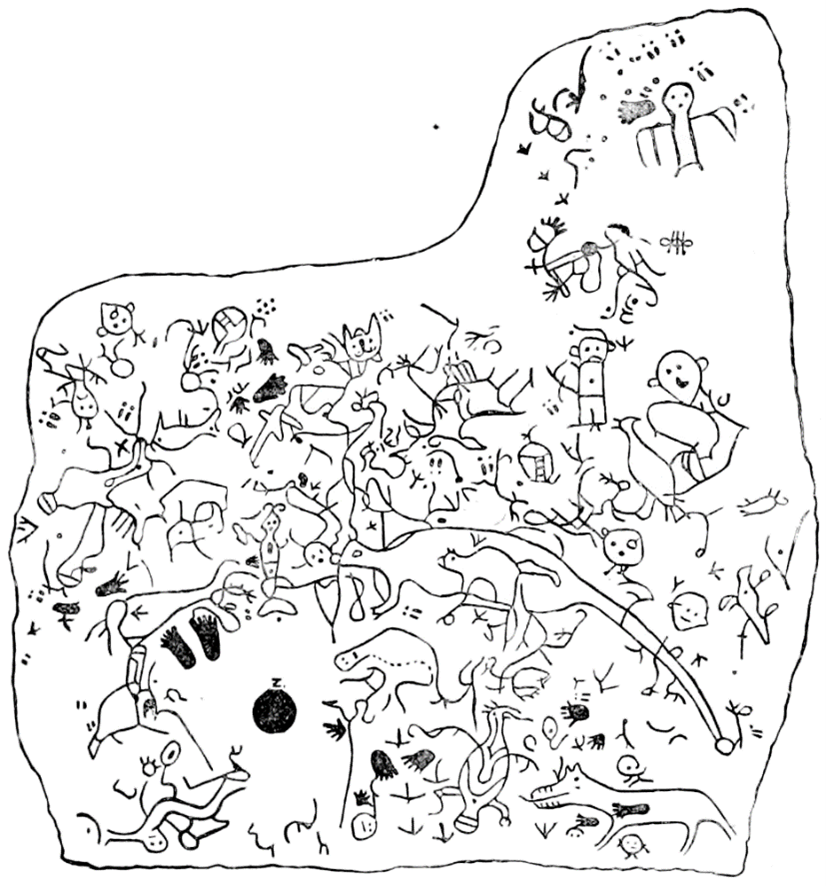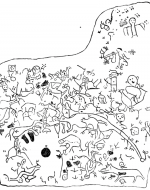Created by Madison Yurich on Thu, 04/25/2024 - 22:20
Description:
The photo displayed above is an Eastern Algonquian pictograph that was copied in 1882 by Messrs. J. Sutton Wall and William Arison. This particular pictograph came from a rock in Fayette County, Pennsylvania, which was an area that was occupied by many Algonquian tribes (“Pictographs”). The rock that this pictograph was etched into is 390 feet above the Monongahela River and is about six feet wide. The rock is now detached from its original formation and the inscriptions are very faded. It can be assumed that many of the carved figures represented animals, which were known to be fundamental characters in the Algonquian creation stories (Ricketts). When copying these figures, Wall said that some of the figures were etched an inch deep into the rock, but there were no indications of tool marks on the rock. He also noted that the carved figures were similar to those discovered in Ohio as well (“Pictographs”).
The Algonquian tribe consisted of many different tribes, from many different regions, that all shared the same Algonquian language. In terms of the Algonquian way of life, they used hunting and fishing methods to obtain food, and also cultivated their own crops, such as squash and corn. Using weapons like bow and arrows and spears during their hunts was also common practice. But of most noteworthy mention, these tribes were the first that the English settlers encountered when they came to North America (“The Algonkian”). Much conflict would arise with these two groups regarding the selling of land, a practice that seemed counterintuitive to the Native Americans. These groups also differed very significantly in terms of culture, for in the Algonquian tribe, the women did the farming and the men did the hunting, and they received much scrutiny from the English for this tradition. Likewise, the Native Americans laughed at the English men who attempted to farm, while the English, who were avid sport hunters in Britain, laughed at the poor hunting skills of the Native Americans (“The Algonkian”). As previously mentioned, times of peace were short, and tensions quickly broke out into conflict amongst these groups in North America.
The English settlers also put a high value on dress and how dress reflected importance and identity. This was very different from the Algonquians whose identity could not be defined by the settlers based on their dress (Willmott 1). Frank Speck was an American anthropologist who became a professor at the University of Pennsylvania in 1925 until 1950. He specialized in the Iroquois and Algonquian tribes of Eastern America, and wrote extensively about the lives of these people, including their cultural dress. He mentions that although dressing in accordance with status was not as popular as it was with the English, these tribes did have unique belts that they would wear to symbolize different eras. For example, during times of war the chief would wear “war belts” and during times of peace, he would wear a “peace belt” (Speck 12). He says, “If any trouble arose in sight of the chief he would send this belt by runners to the chief of the nearest tribe accompanied by his message stating the circumstances. The receiver would then forward it to the chief of the next tribe, and so on, until the belt would ultimately be returned to its starting place” (Speck 13), and also mentions that the same would occur if peace had been declared.
Works Cited
“Pictographs of the North American Indians.” Pictographs of the North American Indians, by Garrick Mallery-The Project Gutenberg eBook, www.gutenberg.org/files/54643/54643-h/54643-h.htm. Accessed 17 Apr. 2024.
Ricketts, Bruce, and Lillian Nunyabizniss. “Home.” Mysteries of Canada, 31 Oct. 2014, mysteriesofcanada.com/first-nations/algonquin-indian/.
Speck, Frank G. “The Eastern Algonkian Wabanaki Confederacy.” American Anthropologist, vol. 17, no. 3, 1915, pp. 492–508. JSTOR, http://www.jstor.org/stable/660500. Accessed 18 Apr. 2024.
“The Algonkian Tribes.” Ushistory.Org, Independence Hall Association, www.ushistory.org/us/1c.asp. Accessed 17 Apr. 2024.
Willmott, Cory. “Beavers and Sheep: Visual Appearance and Identity in Nineteenth-Century Algonquian-Anglo Relations.” History & Anthropology, vol. 25, no. 1, Jan. 2014, pp. 1–46. EBSCOhost, https://doi.org/10.1080/02757206.2013.824269.
Copyright:
Associated Place(s)
Part of Group:
Featured in Exhibit:
Artist:
- Messrs. J. Sutton Wall and William Arison


